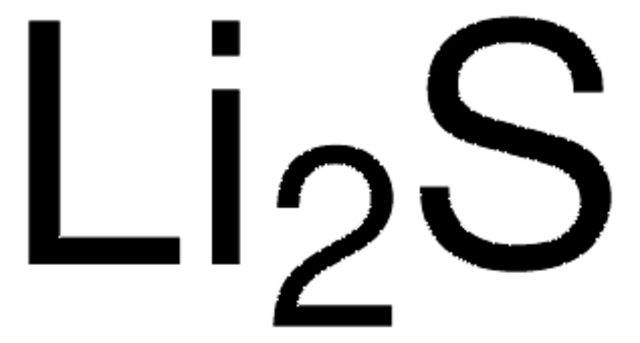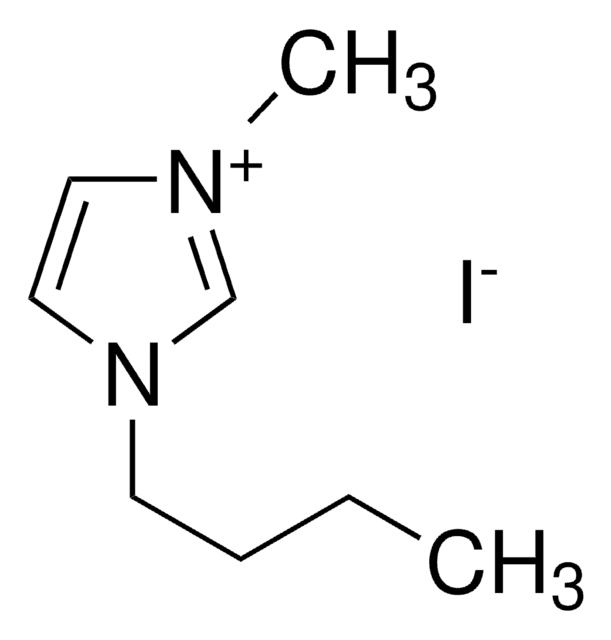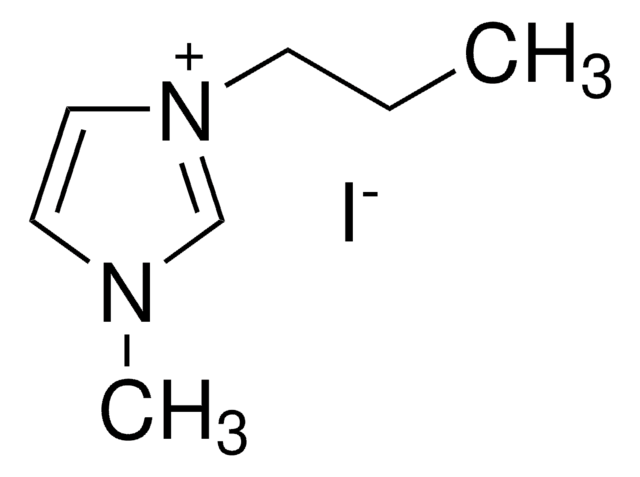About This Item
おすすめの製品
グレード
for synthesis
synthesis grade
製品種目
AnhydroBeads™
アッセイ
99.99% trace metals basis
フォーム
beads
環境により配慮した代替製品の特徴
Design for Energy Efficiency
Learn more about the Principles of Green Chemistry.
sustainability
Greener Alternative Product
不純物
≤150.0 ppm Trace Metal Analysis
粒径
−10 mesh
mp
446 °C (lit.)
密度
3.49 g/mL at 25 °C (lit.)
環境により配慮した代替製品カテゴリ
SMILES記法
[Li+].[I-]
InChI
1S/HI.Li/h1H;/q;+1/p-1
InChI Key
HSZCZNFXUDYRKD-UHFFFAOYSA-M
類似した製品をお探しですか? 訪問 製品比較ガイド
関連するカテゴリー
詳細
アプリケーション
- 溶媒キャスト法を用いた色素増感型太陽電池(DSSC)用のポリマーベースの電解質の合成のための前駆体として。
- 全固体電池を得るための液相合成による、高いイオン移動度を持つ Li2S-P2S5-LiI 結晶性無機-有機ハイブリッド電解質として。
- リチウム–酸素(Li–O2)電池の酸化還元メディエーターとして。電極間でチャージキャリア(電荷担体)を往復させることによって、酸化還元反応を促進します。
特徴および利点
- 高温で優れたイオン伝導率
- 良好な熱安定性
- リチウムベースの電池材料と適合。
法的情報
保管分類コード
11 - Combustible Solids
WGK
WGK 3
引火点(°F)
Not applicable
引火点(℃)
Not applicable
個人用保護具 (PPE)
dust mask type N95 (US), Eyeshields, Gloves
適用法令
試験研究用途を考慮した関連法令を主に挙げております。化学物質以外については、一部の情報のみ提供しています。 製品を安全かつ合法的に使用することは、使用者の義務です。最新情報により修正される場合があります。WEBの反映には時間を要することがあるため、適宜SDSをご参照ください。
労働安全衛生法名称等を表示すべき危険物及び有害物
名称等を表示すべき危険物及び有害物
労働安全衛生法名称等を通知すべき危険物及び有害物
名称等を通知すべき危険物及び有害物
Jan Code
439746-5G-PW:
439746-6X25G:
439746-25G-PW:
439746-30G:
439746-BULK:
439746-5G:4548173988696
439746-25G:4548173988702
439746-VAR:
この製品を見ている人はこちらもチェック
資料
Research and development of solid-state lithium fast-ion conductors is crucial because they can be potentially used as solid electrolytes in all-solid-state batteries, which may solve the safety and energy-density related issues of conventional lithium-ion batteries that use liquid (farmable organic) electrolytes.
ライフサイエンス、有機合成、材料科学、クロマトグラフィー、分析など、あらゆる分野の研究に経験のあるメンバーがおります。.
製品に関するお問い合わせはこちら(テクニカルサービス)










